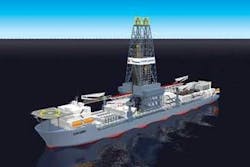New design drillship pushes operations depths to meet future needs
To build the drilling rig of the future, designers need to know what the operations of the future will require. It also helps to know what works today and what needs improvement. These were two of the main questions at Transocean when the decision was reached to plan the rig for the future.
Before two clients signed long-term contracts for three newbuild enhanced Enterprise-Class drillships, Transocean decided to launch design work to push the technology. What provided the last impetus was information from oil and gas operators. Those operators shared programs for wells that cannot be drilled with existing equipment, and this was the final bit of data that resulted in the work now being done on a rig that can meet those next-generation operating parameters.
Transocean spent time studying the demand for ultra deepwater rigs and the prospects which would require them, and concluded that “there is going to be extensive, long-term demand for rigs like the Enterprise class, and for more robust, higher-capacity, efficient rigs,” according to Mike Hall, vice president, engineering and technical services. Once Transocean started working on the design, it sent employees to its West African, Brazilian, and Gulf of Mexico customers to identify what they wanted to see in such a rig.
What came out of those meetings was that anotherDiscoverer Enterprise would not meet all the demands expected in the near future. “So, we started to identify enhancements,” says Hall. There were four big areas in which significant enhancements are being addressed. They are the top drives, mud systems, tree-handling capacities, and power management. The practical results will be seen on the Discoverer Clear Leader when the drillship debuts in 2009, according to the current schedule.
null
Tree handling
Transocean says the Enterprise-class rigs have extensive subsea tree/BOP handling systems. The newbuilds, two that will work for Chevron and one for Hydro, will have even more capacity. “Operators want not just one or two trees, they want three or four assembled, tested, and on the deck ready to go,” says Hall.
TheDiscoverer Clear Leader has an initial contract with Chevron, and Chevron wanted enhanced dual-activity capacity. So, the rig will have two complete BOP stacks, lower marine riser packages, pods, etc. As Transocean sees it, dual activity works especially well in the top-hole stage. The concept is for one rotary to drill the top hole - jetting in casing, drilling out, pulling up, running the next casing - while the main rotary is testing and lowering the BOP stack. In this way, by the time the top hole is done and waiting on cement, the BOP is at the bottom waiting to be moved into place.
“In deepwater, you save as much as three to four days testing and running the BOP and riser,” says Hall. This can be valuable especially in the GoM where the distance between wells may be short. Hall says that while it may be only a six-hour sail to the next location, it can require three or four days to complete the preparation and maintenance required on the BOP stack.
“Not on all the wells, but on the well-planned ones with little or no transit time between well locations, we sometimes find ourselves with the top-hole finished and we are still running the BOP,” says Hall. “In some cases, the BOP is not ready, and that’s just changing ram rubbers, annular elements ... the basic things that have to be done every time you start a new well. So, we and Chevron considered the idea of two BOP stacks. That way, you have one BOP stack on the deck ready to go. When you pull one BOP up and set it back, you move the other one out and you save all the time spent on normal between-well maintenance. We will have this dual BOP arrangement on two of the three newbuilds. When you consider the economics, if it saves even half the time we expect, it pays for itself very early in the drilling contract.”
Efficiency
One significant result of the work being done on theClear Leader design is a more efficient drilling and material-handling operation. That is perhaps best illustrated in the tree handling process. In the rig of the future, production trees will be assembled nearer the well center and will not require as much handling on the rig. The handling system allows for fully assembled trees to be delivered to the rig and lifted onboard in one lift. The system is designed to handle large trees weighing up to about 100 tons. In addition, several trees can be fully tested and ready to go.
This drive for efficiency extends into most of the rig’s subsystems. For instance, the mud system will have excess capacity. Transocean typically uses six shale shakers on its drillships but plans for 10 on the new generation deepwater rigs. In this design, if there is a problem with one of the shakers, it can be bypassed without shutting down operations because of the extra capacity. The design extends into the entire cuttings handling process. Not just the shale shakers, but also the rest of the cuttings-cleaning system all the way to the storage capacity for cuttings after they have been cleaned.
“To retrofit such things, it is hard to find space,” says Hall. “It is not something that was designed in and you end up using a lot of undesirable space in order to accommodate the extra equipment. In the case of the new design, there is a lot of space being dedicated to this equipment. And, we are incorporating the latest cuttings-management technology.
“The rig is being designed to accommodate all the equipment,” says Paul Tranter, vice president of performance and operations at Transocean. “That is going to make it easy to install.”
There are issues surrounding mud handling on rigs without sufficient capacity or deck space. There may be room only for a small tank to catch cuttings, and it may be necessary to slurry the cuttings in order to pump them up to where the tank was placed. In the new design, Transocean is planning to avoid this. In addition to having sufficient tank space to catch cuttings, an auger system is planned to move the dry cuttings into a container placed at the same level as the cuttings outflow.
“From our perspective, it is just providing space at the right elevation rather than having to do some unusual pumping or crane handling,” says Hall.
null
Top drive
The top drive was identified as an area needing improvement. The Enterprise class rigs were designed with 1,000-ton drilling centers. The new drillships will have 1,000-ton crown blocks/traveling blocks and 1,250-ton top drives. On the top-drive side, Transocean is working with Aker Kvaerner MH to develop a more robust top drive than those currently available. One objective of the new design is to limit maintenance requirements so drilling operations are not interrupted. Maintenance would be done as time becomes available rather than on regular intervals. The design approach is to use sealed components and automatic lubrication, along with heavy-duty components that do not require maintenance as often.
“We were seeing units on our Enterprise-class rigs with a life of less than three years before requiring shop time and rebuilding,” says Hall. “It is not because of bad designs, but because of the way we are using rigs these days. The equipment is designed to API specifications, but it is designed under rules written around usage factors existing in the 1950s and 1960s. When you take a dual-activity rig today, that top drive is working much more of the time and it is working near its rated capacity much more of the time.”
As an example, Hall cites Transocean’s experience with the 750-ton unit on the Enterprise-class units. Much of the time, the unit is drilling with 600 to 700 tons, and tripping loads exceed 700 tons.
“We are operating right there near rated capacity most of the time and we are simply wearing the machines out much faster,” he says. “Recognizing that, we are putting in components which should have 10 years-plus life, even if they are used at their rated load a large percentage of the time.”
Transocean and AKMH are looking at another aspect of the top drive, modular design. The target is to have large, modular components which can be removed and replaced with another - on the rig and in a short time. Heretofore, a top drive failure might require a disassembly of the unit while it was hanging in the derrick, or complete removal and shipment to a shore-based shop.
“We are designing the new unit to have a lot longer life between overhauls and to require less intrusive maintenance. If something does happen, we are designing it to be much easier to repair and to be repaired always in the field, never on shore,” says Hall. “With existing units, if something goes wrong and you have a spare top drive, you still may be looking at three days or more of downtime. If you do not have a complete spare unit, a main bearing replacement, for example, typically means taking the unit to the shop. Getting it there, fixing it, getting it back to the rig, and getting it reinstalled can consume six to seven days, minimum.
“If we have all the spare modules for the new unit on the rig, the longest out-of-service time we expect is on the order of eight hours to change out anything - gear box, main bearings, shafts, whatever.”
There is a safety aspect to the modular design, too. It is being designed to sit on the rig floor which means none of the work will have to be done in the derrick. The only height involved will be the height of the top drive, itself. That means scaffolding 15-20 ft high rather than climbing a third of the way up the derrick to a special parking area and possibly requiring a riding belt.
The most complex technical challenge being met involves the power supply. While much of the new hardware on the drillship is an extension or extrapolation of the existing equipment, the power plant design is not. “It is the most interesting challenge and where we are genuinely doing something different,” says Tranter.
Transocean is working in partnership with Siemens to develop a revolutionary electrical-distribution system that will provide enough power under all conditions to every area of the rig. More important, the system will significantly help reduce the risk of power loss or “blackouts” during operations. For example, its enhanced fault-tolerant design will provide greater power availability compared with conventional redundant systems.
In addition, Transocean’s Advanced Generator Protection System will enable the power plant to counter more effectively any electrical problems, should they arise. Kongsberg is providing the DP (dynamic positioning) and control system, and Rolls Royce is supplying the thrusters.
“All of these things have to be completely integrated to give us the reliability we want,” Tranter says. “If any one part of the system breaks, everything halts. So, integrating all of these has been a challenge.”
Gene Kliewer, International Editor



